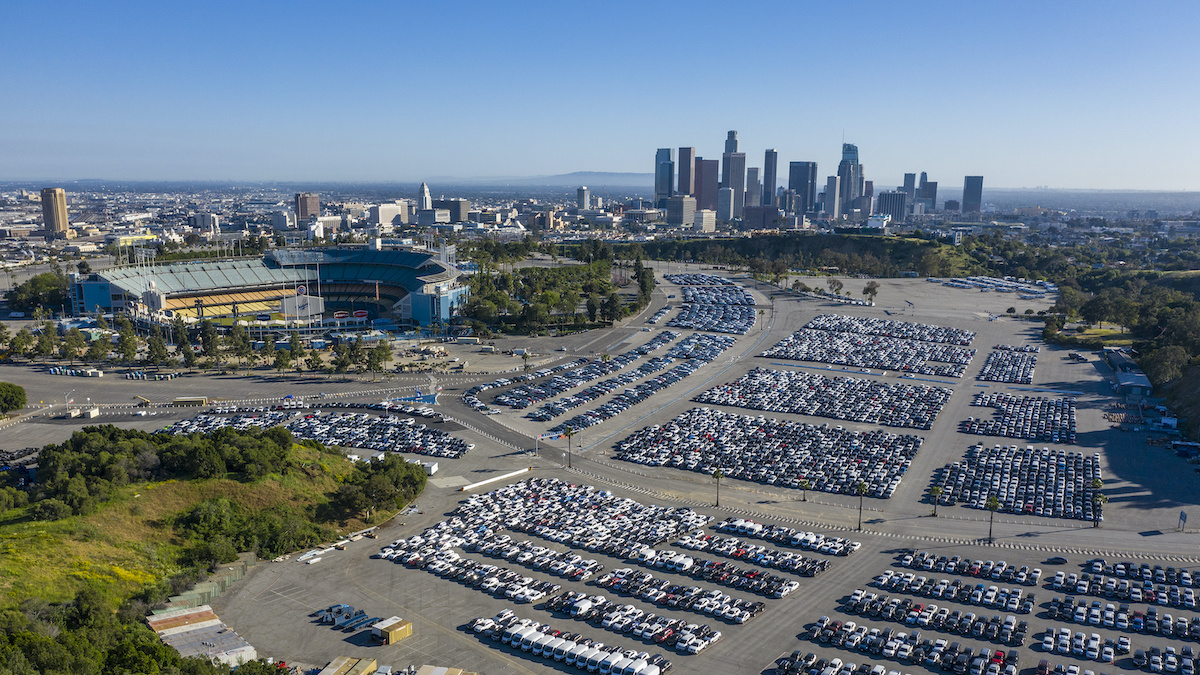

Unused rental cars are stored in the parking lot of dormant Dodger Stadium in Los Angeles, California on April 23, 2020. Clearer skies have followed coronavirus lockdowns around the world. Robert Gauthier / Los Angeles Times via Getty Images
The lockdowns imposed around the globe in response to the coronavirus pandemic led to a record drop in greenhouse gas emissions, according to research published in Nature Climate Change Tuesday.
The researchers found that daily emissions fell by 17 percent during the height of quarantine measures in early April when compared with the same time in 2019, the University of East Anglia (UEA) reported in a press release.
“Globally, we haven’t seen a drop this big ever, and at the yearly level, you would have to go back to World War II to see such a big drop in emissions,” UEA professor of climate change science and lead author Corinne Le Quéré told NBC News. “But this is not the way to tackle climate change — it’s not going to happen by forcing behavior changes on people. We need to tackle it by helping people move to more sustainable ways of living.”
🌍 The #COVID19 global #lockdown has had an “extreme” effect on daily carbon emissions, but it is unlikely to last – according to an international analysis led by UEA: https://t.co/WpYikbgHnA#ClimateChange #ThinkingWithoutBorders pic.twitter.com/Zplu2PgyFG
— UEA (@uniofeastanglia) May 19, 2020
The research is the first major study of emissions this year, according to The Guardian, though the International Energy Agency projected a record 8 percent decline in emissions for 2020. Because it is not possible to measure the change in carbon dioxide emission directly, since the gas remains in the atmosphere for such a long time, researchers instead relied on data for on-the-ground indicators like traffic, energy usage, flights and manufacturing, Wired explained.
That data also revealed the major drivers of the emissions decline, the UEA press release explained. The drop in ground transport, such as cars, was responsible for 43 percent of the decline, while declines in industry and power together accounted for another 43 percent. While air travel was majorly impacted by the pandemic, it only accounted for 10 percent of the emissions drop because it is only responsible for three percent of emissions overall.
The data was gathered from 69 countries responsible for 97 percent of greenhouse gas emissions. At the height of the global response, areas responsible for 89 percent of emissions were under some kind of lockdown. On average, countries saw their emissions fall 26 percent. In the U.S. and the UK, emissions fell by a third, Wired reported.
While these numbers are dramatic, they also illustrate the challenges involved in lowering emissions enough to avoid the worst impacts of the climate crisis.
“This is a really big fall, but at the same time, 83% of global emissions are left, which shows how difficult it is to reduce emissions with changes in behaviour,” Le Quéré told The Guardian.
She also pointed out to Wired that the 17 percent drop at the height of confinement measures only returned emissions to 2006 levels.
“So this is really showing just how much emissions are increasing through time every year. This incredible drop in emissions only takes us back 14 years,” she told Wired.
What happens next will depend on political decisions and how soon lockdown measures are lifted, the press release explained. If they are lifted fully by June, emissions for the year will fall four percent. If some restrictions are in place all year, they will decline by seven percent. That is around the yearly decline needed to meet the Paris agreement climate goals of limiting global warming to “well below” two degrees Celsius above preindustrial levels.
“We would have to have the same speed of reduction that’s happening in 2020 every year for the next decade,” Zeke Hausfather, a climate scientist at the University of California, Berkeley who was not involved with the study, told NBC News.
The researchers called on governments to craft economic recovery plans that encouraged the systemic changes that will ultimately make sustainable emissions declines possible.
“The extent to which world leaders consider climate change when planning their economic responses post COVID-19 will influence the global CO2 emissions paths for decades to come,” Le Quéré said in the press release.
For example, governments could follow the lead of Milan and London in reopening cities in ways that prioritize walking and cycling over driving. Le Quéré suggested to Wired that governments stimulate the economy by directing money towards electric cars.
One positive development is that people around the world now have an illustration of what emissions reductions make possible.
“The most obvious change was the beautiful blue skies we saw from India to Indiana,” study coauthor and Stanford University Earth system science professor Rob Jackson told NBC News. “People can relate to that more than abstract discussions about greenhouse gas emissions — you could just see that skies were clear.”
- Greenhouse Gas Emissions Set for Record Decline Due to ...
- India's Air Pollution Plummets in COVID-19 Lockdown - EcoWatch
- Coronavirus Is Pushing More Work Online. Is That Good for the
- Bluer Skies, Less Greenhouse Gas. What Happens After the ...
- COVID-19 Lockdowns Will Barely Reduce Global Warming, New Study Finds - EcoWatch
- Coronavirus Economic Recovery to Drive Second-Highest CO2 Emissions Jump on Record, IEA Warns

 233k
233k  41k
41k  Subscribe
Subscribe 